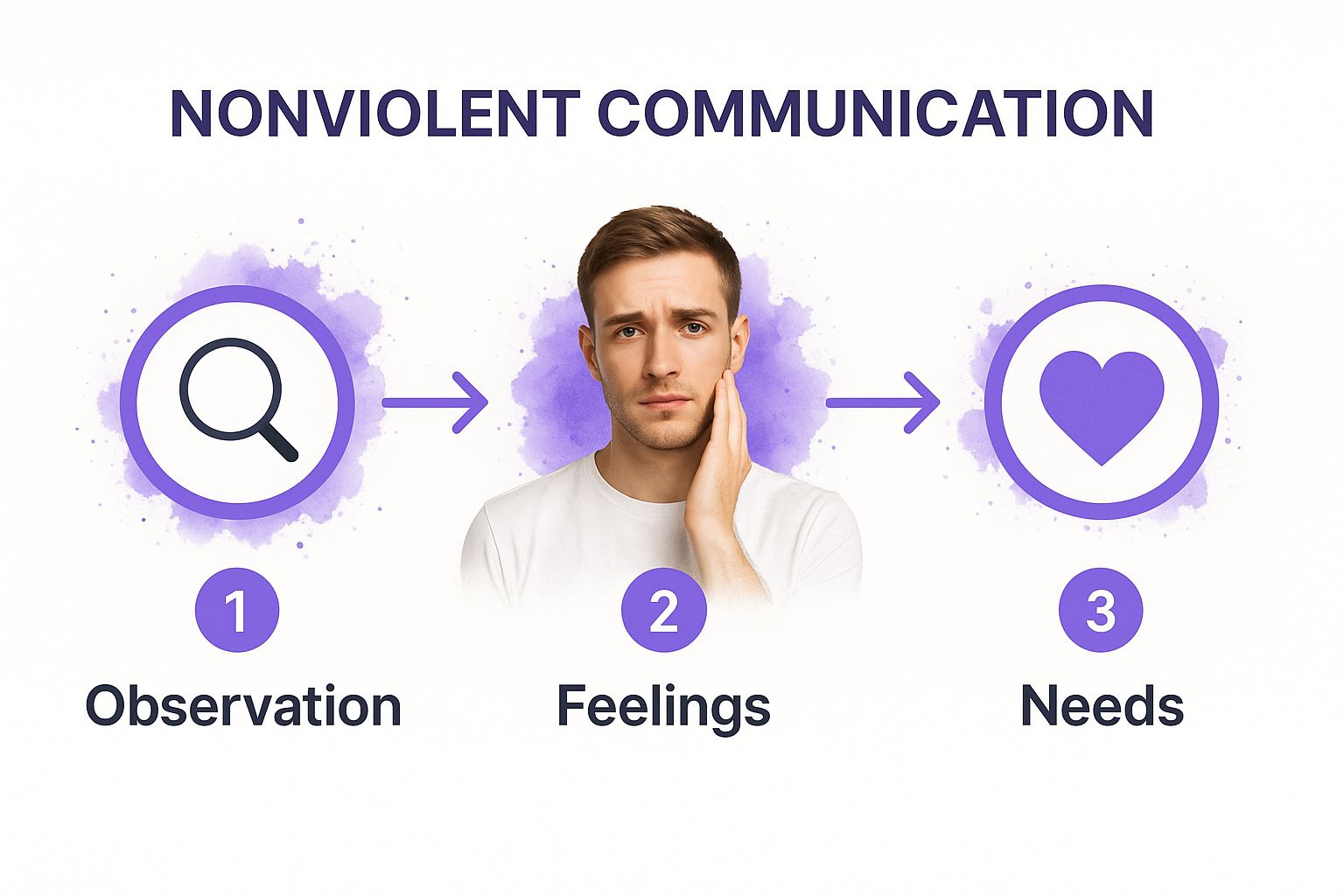Top 8 Tips for Improving Workplace Communication Skills in 2025
Discover effective strategies for improving workplace communication skills and boost your team's success. Learn more now!


In today's fast-paced, collaborative work environments, technical skills can get you in the door, but it's your ability to communicate that truly defines your career trajectory. Effective communication is no longer a 'soft skill'. It is a critical competency that underpins everything from team cohesion and project success to leadership potential and personal influence. Simply 'talking more' is not the answer. The real challenge lies in improving workplace communication skills with intention and precision. Whether you're navigating complex team dynamics, presenting a high-stakes idea, or providing critical feedback, the quality of your communication directly impacts the outcome.
This guide moves beyond generic advice to provide a strategic roundup of eight powerful, actionable techniques designed to transform how you interact, connect, and lead. From mastering the art of listening to leveraging digital tools effectively, these strategies will equip you with the skills needed to not just participate, but to thrive and inspire in any professional setting. Prepare to build stronger relationships, eliminate misunderstandings, and unlock new levels of success by honing the communication skills that matter most.
1. Active Listening Training
Active listening is a structured communication technique that goes far beyond simply hearing words. It requires you to fully concentrate on the speaker, understand their message, respond thoughtfully, and retain the information. This skill is a cornerstone of improving workplace communication skills because it builds trust, fosters collaboration, and prevents the misunderstandings that can derail projects and damage relationships.

When you listen actively, you make the other person feel heard and valued. This conscious effort, popularized by experts like Carl Rogers and Stephen Covey, transforms a simple conversation into a powerful connection. Companies known for their strong cultures, such as Google and Salesforce, integrate active listening workshops into their management and team training programs, leading to higher employee satisfaction and retention.
How to Implement Active Listening
To turn this concept into a practical skill, focus on deliberate actions during conversations.
- Practice the 80/20 Rule: Dedicate 80% of your time to listening and only 20% to speaking. This ratio forces you to absorb more than you transmit.
- Use the RASA Technique: Created by TED speaker Julian Treasure, this acronym stands for Receive (pay attention), Appreciate (use non-verbal cues like nodding), Summarize ("So, what you're saying is..."), and Ask (ask clarifying questions).
- Eliminate Distractions: Put away your phone and close your laptop. Giving someone your undivided attention is the most powerful non-verbal signal of respect.
- Practice Reflective Statements: Begin your response with phrases like, "What I'm hearing is..." or "It sounds like you're feeling..." to confirm your understanding before sharing your own perspective. Mastering these techniques can be especially beneficial for non-native English speakers. You can explore how to improve English listening skills on talk-easy.com for more targeted exercises.
2. Nonviolent Communication (NVC) Method
Nonviolent Communication (NVC) is a systematic framework that teaches people to express themselves and listen to others with empathy and clarity. Developed by Marshall Rosenberg, this method focuses on expressing observations, feelings, needs, and requests without blame or criticism. It is a powerful tool for improving workplace communication skills, as it de-escalates conflict and builds a culture of mutual respect and understanding.
The NVC model transforms difficult conversations by separating objective observations from subjective evaluations. Companies like Zappos use NVC principles in customer service training to foster genuine connection, while tech firms such as Asana integrate its frameworks into conflict resolution processes. This approach, also championed by researchers like Brené Brown, helps teams navigate disagreements constructively, leading to stronger collaboration and psychological safety.
The infographic below illustrates the core process flow of a Nonviolent Communication statement.

This visual guide shows how to structure communication, starting with a neutral observation, connecting it to your feelings, and then identifying the underlying need.
How to Implement Nonviolent Communication
Integrating NVC requires shifting from habitual, often judgmental language to a more conscious and compassionate way of speaking.
- Practice the Four Components: Structure your communication around Observations (what you see/hear), Feelings (emotions, not thoughts), Needs (universal human needs), and Requests (clear, positive actions). For example: "When I see the report is incomplete (observation), I feel worried (feeling), because I need reliability (need). Would you be willing to update it by 3 PM (request)?"
- Use 'I' Statements: Frame your points from your perspective using "I feel..." or "I need..." This avoids accusatory "you" statements that can make others defensive.
- Distinguish Needs from Strategies: A need is a universal value like security or respect. A strategy is one way to meet that need. Focusing on shared needs opens the door to collaborative problem-solving.
- Practice Self-Empathy: Before entering a difficult conversation, use NVC to understand your own feelings and needs. This helps you communicate from a place of clarity and calm, which is a key part of how you can improve your English speaking skills with talk-easy.com.
3. Storytelling and Narrative Techniques
Storytelling is a powerful communication skill that transforms dry information into memorable and persuasive messages. It involves structuring your communication using narrative elements like character, conflict, and resolution to engage your audience on an emotional level. Mastering this technique is essential for improving workplace communication skills, as it helps leaders inspire action, salespeople build rapport, and teams align around a shared vision.

When you frame data and ideas within a story, you make them relatable and easier to understand. This approach, popularized by communication experts like Nancy Duarte and Carmine Gallo, is used by the world's most influential brands. Apple's product launches, for example, aren't just feature lists; they are stories of innovation and user empowerment. Similarly, TED Talks consistently leverage narrative structures to make complex ideas accessible and compelling.
How to Implement Storytelling
You can integrate narrative techniques into your daily professional communication with a few focused strategies.
- Use the STAR Method: Structure professional anecdotes using Situation (set the scene), Task (describe the goal), Action (explain what you did), and Result (share the outcome). This is perfect for interviews and performance reviews.
- Create a Hook: Start your story with a question, a surprising fact, or an emotional statement to grab your audience's attention immediately.
- Show, Don't Tell: Instead of saying a project was "difficult," describe the late nights and specific obstacles your team overcame. Use concrete details to paint a vivid picture for your listeners.
- Build a Story Bank: Keep a personal log of professional experiences, successes, and failures. Having these stories ready allows you to find a relevant one for any situation, from a casual chat to a formal presentation. You can find inspiration for your story bank by reviewing a list of conversation topics for adults on talk-easy.com to spark ideas.
- End with a Clear Takeaway: Every story should have a purpose. Conclude with a clear message, a lesson learned, or a call to action that reinforces your main point.
4. Feedback Sandwich Method and Advanced Feedback Techniques
The Feedback Sandwich, a classic communication technique, involves placing constructive criticism between two pieces of positive feedback. While foundational, modern workplaces are adopting more advanced, direct, and growth-oriented methods. These evolved techniques are crucial for improving workplace communication skills as they foster psychological safety, clarity, and a forward-looking mindset, turning potentially difficult conversations into opportunities for development.
Pioneered by thinkers like Kim Scott ('Radical Candor') and Marshall Goldsmith ('Feedforward'), these advanced models prioritize authenticity and actionable insights over cushioning criticism. Companies like Netflix and Bridgewater Associates have built high-performance cultures around direct feedback, demonstrating its power to drive innovation. Similarly, Adobe's move away from annual reviews to continuous 'Check-In' conversations, often using feedforward principles, has significantly boosted employee engagement and performance.
How to Implement Advanced Feedback Techniques
To deliver feedback that inspires growth, shift from simple formulas to nuanced, structured conversations.
- Use the SBI Framework: Structure your feedback around Situation (where and when it happened), Behavior (the specific, observable actions), and Impact (the consequences of that behavior). This model, used by Microsoft, removes judgment and focuses on facts.
- Practice Feedforward: Instead of dwelling on past mistakes, ask for suggestions for the future. For example, ask a colleague, "Next time I lead a project meeting, what's one thing I could do to make it more effective?"
- Be Specific and Direct: Avoid generalizations like "you're always late." Instead, say, "On Tuesday and Thursday this week, you joined the daily stand-up ten minutes after it started, which meant we had to repeat the initial updates."
- Ask for Permission: A simple "Are you open to some feedback on the presentation?" respects the recipient's autonomy and prepares them to listen. This approach is key to building trust in any professional dialogue. For those communicating across cultures, understanding how to phrase these requests politely is essential and can be practiced through focused English conversation tutoring on talk-easy.com.
5. Emotional Intelligence (EQ) Development
Emotional Intelligence (EQ) is the ability to recognize, understand, and manage your own emotions, as well as to recognize, understand, and influence the emotions of others. Developing this skill is fundamental to improving workplace communication skills because it moves interactions beyond the purely transactional. EQ allows you to navigate the complex emotional undercurrents of professional relationships, leading to more empathetic, persuasive, and effective communication.
This concept, popularized by psychologist Daniel Goleman, is built on five core competencies: self-awareness, self-regulation, motivation, empathy, and social skills. Companies that invest in EQ development see tangible results. For example, Google’s "Search Inside Yourself" program combines mindfulness and EQ to boost collaboration, while PepsiCo has found that executives with high EQ are more successful in managing their teams.
How to Implement Emotional Intelligence Development
Building your EQ is an ongoing practice that starts with introspection and extends to your interactions with others.
- Start with Self-Awareness: Keep a journal to track your emotional responses to workplace events. Identifying your triggers and patterns is the first step toward managing them.
- Practice the 'Pause': When you feel a strong emotional reaction coming on, take a deep breath before you speak or act. This simple pause creates space for a more thoughtful response instead of a reactive one.
- Develop an Emotion Vocabulary: Move beyond "mad" or "happy." Learning to precisely label your feelings, such as "frustrated," "anxious," or "inspired," helps you understand and manage them more effectively. This is a crucial skill for articulate expression.
- Seek Regular Feedback: Ask trusted colleagues or mentors how your emotional expressions affect them. This external perspective is invaluable for understanding your impact on others. This can be especially important in cross-cultural environments where emotional cues may differ. To build confidence in expressing these complex ideas, you can practice speaking with an AI tutor at talk-easy.com for a low-pressure environment.
6. Public Speaking and Presentation Skills Training
Public speaking and presentation skills training offers a systematic approach to communicating ideas effectively to a group. It moves beyond simply speaking loudly; it involves mastering verbal delivery, body language, visual aids, and audience engagement. This training is a crucial component of improving workplace communication skills because so much of modern business, from team updates to client pitches, hinges on one's ability to present information clearly and persuasively.

This discipline, popularized by pioneers like Dale Carnegie and organizations such as Toastmasters International, equips professionals with the confidence and techniques to command a room. Companies recognize its value; Salesforce mandates presentation training for its managers to ensure effective internal communication, and McKinsey & Company's famous 'Pyramid Principle' training helps its consultants deliver structured, impactful presentations. A well-delivered presentation can secure funding, align teams, and advance careers.
How to Implement Public Speaking and Presentation Skills
Developing strong presentation skills requires consistent practice and a focus on specific, actionable techniques.
- Structure with the 'Rule of Three': Structure your key messages in groups of three. This classic rhetorical device makes your points more memorable and easier for the audience to digest.
- Practice with Video Recording: Record yourself practicing your presentation. Watching it back provides invaluable, objective feedback on your pacing, gestures, and filler words like "um" or "ah."
- Design for Clarity, Not Detail: Create slides with one key idea per slide and minimal text. Your slides should support your message, not replace it. Visuals are there to enhance understanding, not to be read aloud.
- Use Strategic Pauses: A well-timed pause can add emphasis, build anticipation, or give your audience a moment to process complex information. Don't be afraid of silence; use it as a powerful tool.
- Join a Practice Group: Organizations like Toastmasters provide a safe, supportive environment to practice regularly and receive constructive feedback. Repetition builds confidence and refines your delivery. You can also explore specific guidance to help you sound more professional on talk-easy.com for additional vocal coaching tips.
7. Cross-Cultural Communication Training
Cross-cultural communication training is a crucial discipline for equipping professionals to interact effectively across diverse cultural backgrounds. It involves understanding variations in communication styles, including directness, hierarchy, time perception, and non-verbal cues. This skill is a cornerstone of improving workplace communication skills in a globalized world, as it builds cultural intelligence (CQ), reduces friction, and fosters genuine inclusion.
When you navigate cultural nuances successfully, you prevent misunderstandings that can stall projects and create unintended offense. This conscious effort, advanced by experts like Geert Hofstede and Erin Meyer, transforms international collaboration from a challenge into a competitive advantage. Companies like IBM and Ericsson have implemented robust cross-cultural training, seeing dramatic improvements in team performance and project success rates across their global operations.
How to Implement Cross-Cultural Communication
To develop this skill, focus on awareness, adaptation, and curiosity in your daily interactions.
- Learn Cultural Frameworks: Familiarize yourself with models like Meyer's 'Culture Map' or Hofstede's cultural dimensions. Understanding concepts like high-context vs. low-context communication provides a roadmap for adapting your style.
- Adapt Your Approach: Be more explicit and literal in low-context cultures (e.g., Germany, USA) but pay more attention to non-verbal cues and relationship-building in high-context cultures (e.g., Japan, Saudi Arabia).
- Ask, Don't Assume: Instead of guessing intent, use clarifying questions. Phrases like, "Could you help me understand your expectation for the timeline on this?" can prevent major misalignments.
- Master Language Nuances: For non-native English speakers, cultural training is as important as language proficiency. Understanding how culture shapes professional English can prevent misunderstandings. You can build this confidence by working with a professional English tutor at talk-easy.com who can provide culturally relevant feedback.
- Practice Patient Observation: Pay attention to how colleagues from different backgrounds communicate in meetings. Notice who speaks, how feedback is given, and how decisions are made. This observation is a powerful learning tool.
8. Digital Communication Etiquette and Effectiveness
Digital communication etiquette is the art and science of conveying messages clearly and professionally across platforms like email, instant messaging, and video conferencing. It involves mastering written tone, choosing the right channel for your message, and building rapport without face-to-face interaction. This skill has become essential for improving workplace communication skills, especially in remote and hybrid settings where the absence of non-verbal cues can lead to misunderstandings.
Mastering digital body language, a concept popularized by author Erica Dhawan, is about closing the empathy gap created by screens. Companies that excel at this, like the fully remote GitLab, have codified their communication practices, enabling seamless global collaboration. Similarly, Automattic, the company behind WordPress, uses internal blogs for asynchronous updates, proving that thoughtful digital systems can drive productivity and connection.
How to Implement Digital Communication Etiquette
To turn this theory into daily practice, focus on bringing clarity, intention, and empathy to every digital interaction.
- Apply the Five-Sentence Rule: For emails, aim to keep your message under five sentences. If it requires more detail, a call or a shared document is a more effective format.
- Match the Channel to the Urgency: Use instant messaging for quick, urgent questions. Reserve email for formal or non-urgent matters that require a documented response. Use video calls for sensitive or complex discussions.
- Use Formatting for Scannability: Employ bolding, bullet points, and numbered lists to break up text in emails and messages. This helps your reader quickly grasp the key takeaways and required actions.
- Assume Positive Intent: The lack of tone in text makes it easy to misinterpret messages. Before reacting, read a message again and assume the sender had good intentions. This simple mindset shift can prevent unnecessary conflict and is a core part of effective team communication.
8 Workplace Communication Skills Comparison
| Technique | Implementation Complexity 🔄 | Resource Requirements 💡 | Expected Outcomes 📊 | Ideal Use Cases 💡 | Key Advantages ⭐ |
|---|---|---|---|---|---|
| Active Listening Training | Moderate 🔄 | Low to Moderate 💡 | Better understanding, reduced conflicts 📊 | One-on-one meetings, coaching, healthcare | Builds trust, empathy; reduces misunderstanding ⭐ |
| Nonviolent Communication (NVC) | High 🔄 | Moderate to High 💡 | Conflict reduction, psychological safety 📊 | Conflict resolution, feedback sessions | Enhances empathy; fosters authentic communication ⭐ |
| Storytelling & Narrative Techs | Moderate 🔄 | Low to Moderate 💡 | Increased engagement and persuasion 📊 | Presentations, sales pitches, change mgmt | Makes complex info memorable; emotional connection ⭐ |
| Feedback Sandwich & Advanced | Low to Moderate 🔄 | Low to Moderate 💡 | Improved feedback quality and growth 📊 | Performance reviews, coaching | Balances positivity & criticism; reduces defensiveness ⭐ |
| Emotional Intelligence (EQ) Dev | High 🔄 | Moderate to High 💡 | Enhanced leadership, conflict resolution 📊 | Leadership, team management | Improves self-awareness, relationships, adaptability ⭐ |
| Public Speaking & Presentation | Moderate to High 🔄 | Moderate 💡 | Increased influence and clarity 📊 | Meetings, pitches, conferences | Boosts confidence, persuasion; career advancement ⭐ |
| Cross-Cultural Communication | High 🔄 | Moderate to High 💡 | Reduced misunderstandings; inclusive culture 📊 | Global teams, international negotiations | Builds cultural intelligence; improves collaboration ⭐ |
| Digital Communication Etiquette | Moderate 🔄 | Low to Moderate 💡 | Better clarity, productivity, fewer errors 📊 | Remote/hybrid work, digital teamwork | Enhances remote collaboration; reduces overload ⭐ |
From Theory to Practice: Integrating These Skills into Your Daily Work
We've explored a comprehensive toolkit for improving workplace communication skills, moving beyond generic advice to offer specific, actionable strategies. From the profound empathy of Active Listening and Nonviolent Communication to the structural clarity of the Feedback Sandwich and the influential power of storytelling, each method offers a unique pathway to becoming a more effective and respected professional.
The journey doesn't end with reading this article. True mastery comes from consistent, intentional application. The gap between knowing what to do and actually doing it is where most efforts stall. The key is to transform these concepts from abstract theories into ingrained habits that become a natural part of your professional identity.
Your Action Plan for Lasting Change
Avoid the trap of trying to implement everything at once. This approach often leads to overwhelm and abandonment. Instead, adopt a focused, incremental strategy for sustainable growth.
- Start Small, Win Big: Choose just one or two techniques that resonate with you the most. Perhaps it's focusing on paraphrasing and asking clarifying questions during your next team meeting (Active Listening) or consciously observing body language to better gauge reactions (Emotional Intelligence).
- Set a Weekly Goal: Dedicate one week to practicing a single skill. For example, make it a goal to use the Situation-Behavior-Impact (SBI) model for any piece of constructive feedback you give. This focused practice builds muscle memory.
- Reflect and Adjust: At the end of the week, take ten minutes to reflect. What worked? What was challenging? What impact did you notice on your interactions and relationships? This reflection is crucial for refining your approach and building momentum.
The Compounding Value of Clear Communication
Mastering these skills is not just about avoiding misunderstandings; it's a strategic investment in your career and your organization's success. Effective communicators are seen as leaders. They build trust, foster psychological safety, and drive collaboration more effectively. They navigate conflict with grace, inspire action with compelling narratives, and ensure everyone is aligned, whether they're in the same room or collaborating across continents.
Your commitment to improving workplace communication skills directly translates into stronger relationships, increased influence, and more impactful results. It is the single most powerful lever you can pull to accelerate your professional growth.
Ultimately, this journey is about moving from a passive participant to a proactive, influential communicator. It's about building bridges, not walls. By integrating these techniques into your daily work, you will not only enhance your own performance but also elevate the effectiveness and morale of your entire team. The change begins with your next conversation.
Ready to put these skills into practice in a safe, supportive environment? TalkEasy provides AI-powered conversation practice to help you master difficult conversations, rehearse presentations, and build unshakable confidence. Start your journey toward becoming a more influential communicator today at TalkEasy.